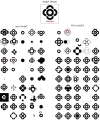Sociality influences cultural complexity
- PMID: 24225461
- PMCID: PMC3843838
- DOI: 10.1098/rspb.2013.2511
Sociality influences cultural complexity
Abstract
Archaeological and ethnohistorical evidence suggests a link between a population's size and structure, and the diversity or sophistication of its toolkits or technologies. Addressing these patterns, several evolutionary models predict that both the size and social interconnectedness of populations can contribute to the complexity of its cultural repertoire. Some models also predict that a sudden loss of sociality or of population will result in subsequent losses of useful skills/technologies. Here, we test these predictions with two experiments that permit learners to access either one or five models (teachers). Experiment 1 demonstrates that naive participants who could observe five models, integrate this information and generate increasingly effective skills (using an image editing tool) over 10 laboratory generations, whereas those with access to only one model show no improvement. Experiment 2, which began with a generation of trained experts, shows how learners with access to only one model lose skills (in knot-tying) more rapidly than those with access to five models. In the final generation of both experiments, all participants with access to five models demonstrate superior skills to those with access to only one model. These results support theoretical predictions linking sociality to cumulative cultural evolution.
Keywords: copying; cultural evolution; culture; evolution; social learning.
Figures




References
-
- Dean LG, Kendal RL, Schapiro SJ, Thierry B, Laland KN. 2012. Identification of the social and cognitive processes underlying human cumulative culture. Science 335, 1114–1118 (doi:10.1126/science.1213969) - DOI - PMC - PubMed
-
- Pagel M. 2012. Wired for culture: origins of the human social mind. New York, NY: WW Norton & Company
-
- Pradhan GR, Tennie C, van Schaik CP. 2012. Social organization and the evolution of cumulative technology in apes and hominins. J. Hum. Evol. 2012, 1–11 (doi:10.1016/j.jhevol.2012.04.008) - DOI - PubMed
-
- Whiten A, Hinde RA, Laland KN, Stringer CB. 2011. Culture evolves. Phil. Trans. R. Soc. B 366, 938–948 (doi:10.1098/rstb.2010.0372) - DOI - PMC - PubMed
-
- Aoki K, Lehmann L, Feldman MW. 2011. Rates of cultural change and patterns of cultural accumulation in stochastic models of social transmission. Theor. Popul. Biol. 79, 192–202 (doi:10.1016/j.tpb.2011.02.001) - DOI - PubMed
Publication types
MeSH terms
LinkOut - more resources
Full Text Sources
Other Literature Sources
Medical
